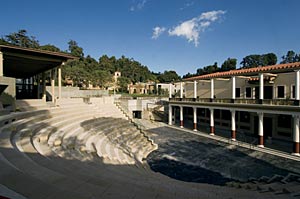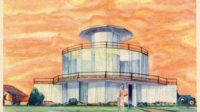City of dreams
While in Los Angeles, I had a chance to revisit a very different museum, the Getty Villa—not the Richard Meier–designed white monastery on a hilltop, but the original Getty that was built in 1979 to hold the oilman’s art collection, and which then was greatly enlarged in 2006 by Boston architects Machado and Silvetti.


It’s often said that Los Angeles is the city of dreams and fictions.
If that’s true, the Getty must be its ultimate exemplar.
For starters, the original Getty was modeled on an ancient Roman villa, the Villa dei Papiri in Herculaneum. But the Papiri has never been fully excavated, so the attempt to replicate it was, in part, an inventive fiction to begin with. That it is a Roman villa located in a hidden valley a short walk from the Pacific Ocean adds one more dreamlike quality.
The group I was with toured the Getty’s famous conservation labs. We saw the magical craft by which restoration masters can create a complete Classical vase from a mere pile of clay fragments, fragments that may add up in total to only a small fraction of the original vase. Somehow, the restorers know what should be the shape of the vase, and where the fragments should fit, and they finish the vase with ceramic work of their own. There’s a parallel here: The ceramic restorers are doing very much the same thing the villa’s original architect did, namely creating an artistic whole out of fragmentary and inadequate evidence. The resulting vase certainly isn’t fiction, but it isn’t quite reality either.
The contribution of Machado and Silvetti is to superimpose, on all these fictions, a totally off-the-wall metaphor. Jorge Silvetti says it didn’t occur to him until he was years into the project. The problem was how to surround the villa with a lot of new stuff—a restaurant, the conservation labs, and an outdoor amphitheater, among other things—yet keep it feeling like a whole, not a bunch of unrelated parts. The solution was to pretend that the site was an archaeological dig. We are to imagine that the dig has uncovered, down at its bottom, the ancient villa. The walls of this mock-excavation site are striated in different textures of concrete and stone, as if they represented layers of historic settlement. We enter near the top, looking down at the villa below. The new buildings seem to be carved from the excavation walls. They don’t have to look Classical because, of course, in the archaeological fiction, they may have arrived on the site at a later date than the villa.
An unlikely confrontation
As a final act of surrealism, the new amphitheater, which does look very Classical, slopes down to a stage floor that also functions as the paved forecourt of the villa. The building’s entrance facade, therefore, doubles as the “set” for productions in the amphitheater. As Silvetti is quick to admit, this is a totally inaccurate portrayal of Roman culture. A theater and a villa would never have confronted each other in this way. But at the Getty, that confrontation is the stroke of something like genius that makes the whole complex work, creating a center of gravity that magnetizes everything around it.
In the evening, we dined among the columns of the peristyle that surrounds the villa’s garden court. A soft, misty Mediterranean-like rain began to fall, not enough to be an annoyance but enough to wet the pavements, which then began to glow with reflected lamplight. The villa, with all its dramas and fictions, was suspended in a time and place somewhere between Hollywood and Herculaneum. It was very beautiful.




Post a comment to this article
Report Abusive Comment